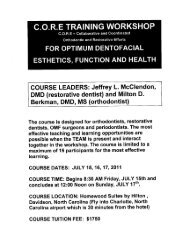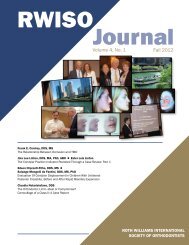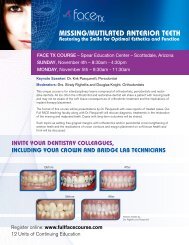2010 RWISO Journal - Roth Williams International Society of ...
2010 RWISO Journal - Roth Williams International Society of ...
2010 RWISO Journal - Roth Williams International Society of ...
Create successful ePaper yourself
Turn your PDF publications into a flip-book with our unique Google optimized e-Paper software.
pending upon the direction in which the arbitrary earpiece<br />
face-bow hinge axis was displaced from the true hinge axis,<br />
the premature contacts occurred either anterior or posterior<br />
to the actual arc <strong>of</strong> closure. Total error that could occur at<br />
the second molar cusp ranged from 0.15 mm <strong>of</strong> open cuspal<br />
space to 0.4 mm <strong>of</strong> excess cuspal height. The mesiodistal<br />
error <strong>of</strong> the second molar cusps ranged from 0.51mm toward<br />
the distal to 0.52 mm toward the mesial. 6 Brotman also<br />
found that a 0.09-mm A-P discrepancy would occur between<br />
occluding casts if the arbitray earpiece face-bow hinge axis<br />
was improperly located by as much as 3 mm from the true<br />
hinge point. Brotman concluded that if the arbitrary earpiece<br />
face-bow hinge axis is incorrectly placed superior to the true<br />
hinge axis, the lower cast will occlude in a more protrusive<br />
direction, with premature contacts on the anterior teeth.<br />
If the arbitrary earpiece face-bow hinge axis is incorrectly<br />
placed inferior to the true hinge axis, the lower cast will occlude<br />
in a more distal direction, with premature contacts on<br />
the posterior teeth. 43 This conclusion resembles the findings<br />
<strong>of</strong> Gordon et al. Weinberg and Fox drew similar conclusions;<br />
the values they obtained for calculated horizontal error in<br />
cusp heights closely resembled each other. 35,44 This suggests<br />
that errors <strong>of</strong> several millimeters in axis location might produce<br />
occlusal errors that are clinically intolerable on the part<br />
<strong>of</strong> the patient. 43<br />
The authors <strong>of</strong> the present study found a mean difference<br />
in incisor position <strong>of</strong> 3.04 mm. The occlusal discrepancies<br />
found in the present study suggest that a range greater<br />
than 5 mm existed between hinge axis points located with<br />
the arbitrary earpiece face- bow mounting and the true hinge<br />
face-bow. The discrepancy in maxillary cast position found<br />
in this study might possibly introduce a change in the closure<br />
<strong>of</strong> the mandible into occlusion. The problems caused<br />
by the occlusal errors resulting from inaccurate location <strong>of</strong><br />
the hinge axis point are illustrated in Figure 10. The photos<br />
suggest an exaggerated discrepancy between the two casts<br />
because two completely different face-bow techniques were<br />
used. They serve to illustrate occlusal error that may result<br />
from error in maxillary cast position. In some cases, however,<br />
the autorotated mandibular casts closed with only a<br />
small degree <strong>of</strong> occlusal error (Figure 9). Other casts showed<br />
severe positional changes resulting in larger occlusal errors<br />
when this was attempted. (Figure10).<br />
Figure 10-a Mounted maxillary estimated cast vs.<br />
true hinge mounted maxillary cast: True hinge mounting.<br />
Figure 10-b Mounted maxillary estimated cast vs.<br />
true hinge mounted maxillary cast: Estimated hinge mounting<br />
substituted for true hinge maxillary mounting.<br />
It may be difficult to detect which patients have arbitrary<br />
earpiece face-bow hinge points naturally located within<br />
5 mm <strong>of</strong> their true hinge point. Therefore, if any degree <strong>of</strong><br />
accuracy is needed or if any change in vertical dimension,<br />
such as an occlusal equilibration or orthognathic surgery, is<br />
planned, use <strong>of</strong> a true hinge axis face-bow should be considered.<br />
Previous studies have suggested that location <strong>of</strong> a<br />
kinematic true hinge axis point prior to treatment for dentulous<br />
patients who require extensive treatment saves time and<br />
results in a more satisfactory occlusion. 6 The present study<br />
found a statistically significant difference in the maxillary<br />
cast position in all three planes <strong>of</strong> space between the two<br />
face-bow techniques compared.<br />
Conclusions<br />
1. Statistically significant differences (p < .001) were<br />
found between the true hinge face-bow mounted maxillary<br />
cast and the estimated earpiece face-bow hinge mounted max-<br />
<strong>RWISO</strong> <strong>Journal</strong> | September <strong>2010</strong><br />
53








